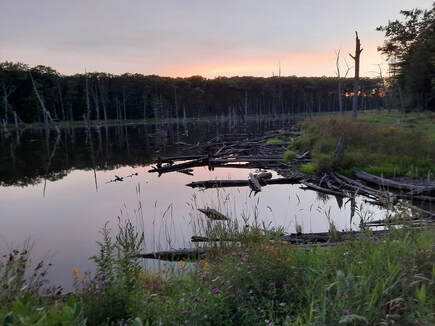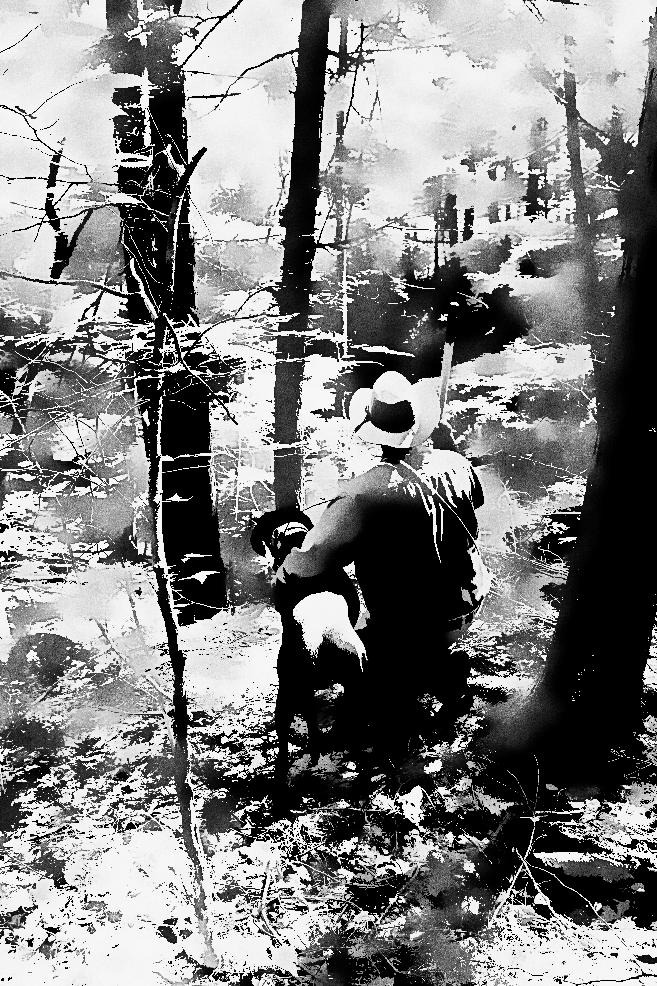 A late summer photo of the larger swamp mentioned in this story. A late summer photo of the larger swamp mentioned in this story. Editorial: I was going to “fictionalize” this tale—and make it a new story about Nathan Ernst and the character Seth. Then I realized, this true event had a close parallel to the fateful scene in Wilson Rawl’s Where the Red Fern Grows, and some might think I was plagiarizing this classic work. I assure you what you’re about to read happened. . . . (4-minute read) The forest air grew crisp this mid-October night. With such a dry summer and early fall in Upstate New York, the raccoon were traveling to the few remaining water sources as many of the normally flowing creeks were now dry. It was still training season—but even experienced hounds benefit from a good run—and the chances of striking a ringtail’s trail near somewhere wet was our best bet. Seth and our older hound Buck* had already disappeared into the darkness beyond my headlamp’s reach. After 10 minutes on a trail that neared the northern end a small swamp, Seth’s deep voice opened less than 75 yards away. I turned off my headlamp and waited in the dark. The chase was on. The GPS-equipped collars on each hound let me watch the hunt’s progress on my digital tracking device. They were moving fast—very fast—heading toward a larger swamp not far away. In less than a minute, they were already over two hundred yards out and at a dead run. Even Buck, normally tight-mouthed (i.e., he only barks once or twice before treeing a raccoon) had become caught up in the Seth’s excitement and open trailed often. Normally, I wait for our hounds to tree before closing in. A raccoon’s path is often erratic—and while ringtails follow recognizable patterns in a given forest from one generation to the next—it’s often best simply to let the hounds run the track and tree before moving. But something in Seth’s voice—and Buck’s abnormally vocal nature—convinced me to head to them sooner rather than later. After so many hunts, older hunters learn to trust their instincts. This night, I’m glad I did. The trail I followed wasn’t the most direct route to where the hounds were headed. It twisted and turned like s snake, but it would get me closer and allow a faster pace versus traveling through the open woods. The hounds’ pace slowed. When I was only about a hundred yards from them, something changed. Seth’s open trail bark switched to a “face bark”—and that couldn’t be good. A face bark meant whatever my hounds had been chasing had now decided to fight. A healthy raccoon doesn’t make a stand but would seek safety by climbing high into the upper limbs of a tree. Immediately, my mind started going through the possibilities. It wasn’t a porcupine: nature’s slow-moving pincushion wouldn’t have run what had become a more than 400-yard chase. What then? A rabid raccoon? Rabies had devastated the ringtail population in our hills 30 years ago. But—as my retired, New York State Forest Ranger father will tell you—once rabies enters an area, it never completely leaves. For some reason, Seth’s lineage came to mind. Through his mother, Seth came from a bloodline of famous mountain lion and (grizzly) bear hounds** from out west. Could this unknown quarry be a bear? I broke into a clearing at the base of the larger swamp and only taken two steps into the field when Buck joined me. Another bad sign. While Buck normally won’t chase anything other than a raccoon, he’d likely become caught up in the younger hound’s enthusiasm and followed along. But when whatever they’d chased tonight hadn’t gone up a tree, Buck abandoned the scene and came to me. I moved apace to where my light had found Seth at the edge of the field nearly 80 yards away. And then I saw it. It wasn’t a bear, but from its dark shape and large size, I could tell it wasn’t a raccoon either. Further, it had cleverly situated itself beneath a heavy bush that would confound any frontal assault. “Seth! Get away from there!” I shouted. My stubborn hound refused the command, keeping his eyes on his prey. It was a good thing he kept focus, for the beast lunged at him far faster than I’d ever seen any raccoon move. But Seth was faster, moving laterally just enough miss the creature’s assault. “Seth! Come here!” I shouted. This time, my command had two effects. Whatever had been bayed now fled. And with me so near (about 20 yards), Seth finally obeyed and came toward me several yards. But Seth is nothing if not determined and quickly turned around to pursue his prey again. About 30 yards away, he treed on a huge oak, still holding onto its fall foliage. When I arrived, I couldn’t see what had climbed into the tree’s high limbs, but I knew what is was: a bobcat.*** I called Seth off, and this time he obeyed. No one could fault him for chasing what was in his blood—the desire to chase a big cat. I’m thankful I arrived when I did. though, recalling stories of hapless coonhounds encountering bobcats that ending with the dogs’ faces and ears shredded by a bobcat’s sharp claws. But the story doesn’t end there. About a fortnight later—with hunting season now open—I came across the largest bobcat I’d ever seen while driving home with Seth after a successful hunt. This cat was about 300 yards from where this story’s chase began. Taking in his size, I understand why some claim to see eastern cougars from time to time. (But rest assured, this was a bobcat.) I watched it bound away incredibly fast across the clearing into the forests—a magnificent creature. I’ll never know for certain if this was the same cat who had danced with Seth a short time before. By their nature, bobcats are extremely elusive. Why this wild feline stood long enough by the roadside as my truck had neared to allow a good look, I can’t say. He might have been temporarily mesmerized by the headlights, or I may have upset a hunt as he pursued his own game that night. Or maybe, he was letting us know that it was him we’d chase that night, saying: Get a good look, for you’ll never see me again. It’s hard sayin’. But then again, it is Painted Post. * * * *Yes, just as there is a real Seth and a character Seth in the Ryland Creek series, there is also a real and fictional Buck, although Seth and Buck are not related in real life. **The Cameron hounds—a line of superb hounds started by Del Cameron—a famously tough hunter who died in early 2020 in his eighties. *** Truth be told, I first thought it was a feral cat, which can reach 30 pounds in the wild. It was my later viewing of the big bobcat that convinced me I had actually seen a bobcat that night with Seth.
0 Comments
Your comment will be posted after it is approved.
Leave a Reply. |
Categories
All
|
- Ryland Creek
- About The Ryland Creek Novels
- Buy the Ryland Creek Saga: Print Books
- Buy the Ryland Creek Saga in E-Book
- The Ryland Creek Saga in Audiobook
- Blog: In a place called Painted Post
- Reader Reviews for The Ryland Creek series
- Meet the Author:Joseph Gary Crance
- An Ode to Painted Post
- The Magical Realism of the Ryland Creek Saga
- Other local authors
- Contact
- Leave A Reader Review
- Ryland Creek
- About The Ryland Creek Novels
- Buy the Ryland Creek Saga: Print Books
- Buy the Ryland Creek Saga in E-Book
- The Ryland Creek Saga in Audiobook
- Blog: In a place called Painted Post
- Reader Reviews for The Ryland Creek series
- Meet the Author:Joseph Gary Crance
- An Ode to Painted Post
- The Magical Realism of the Ryland Creek Saga
- Other local authors
- Contact
- Leave A Reader Review

 RSS Feed
RSS Feed